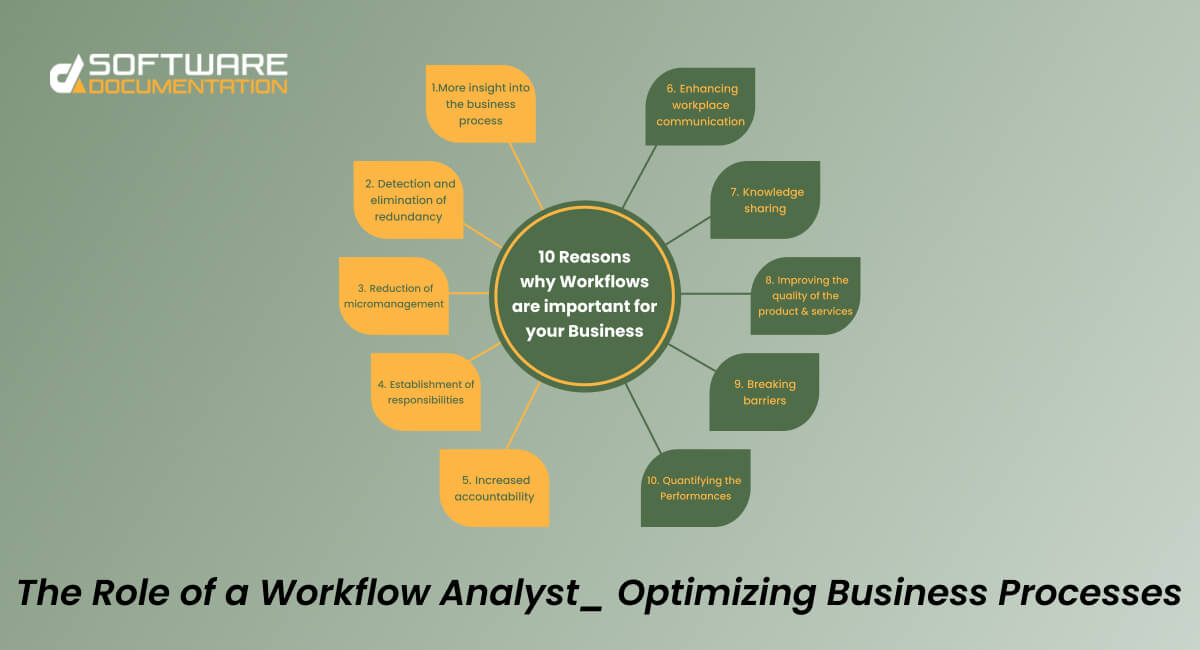Introduction
In all organizations, it is always important to ensure that work is done efficiently so as to achieve success. Businesses in their attempts to become more efficient, produce more and spend less seek means to optimize their performance. In this effort, a Workflow Analyst is very instrumental since they deal with the analysis and management of processes to ensure that all goes as planned. In the following article, we will explore the detailed description of the Work Flow Analyst’s role, the tools employed in the process and how the Analyst ultimately enhances operational efficiency.
What is a Workflow Analyst?
A workflow analyst is a person who analyzes and documents process improvement and streamlines organizational business processes. The major purpose for their usage is to find out where the problems are, that is, where there is waste, or where there is opportunity for improvement. In this way, they contribute to increased organizational effectiveness, increased employees’ effectiveness, and overall organizational performance.
An example of professionals involved in this step are the Workflow Analysts who have to coordinate with different departments within an organization in order to understand the current workflow, to collect specific requirements, and to make recommendations for its changes. They make sure that the processes being implemented are not only smooth and in line with organizational objectives.
Key Responsibilities of a Workflow Analyst
A Workflow Analyst’s work description therefore does not only entail analyzing workflows at the outward view. Here are some of their primary responsibilities: Here are some of their primary responsibilities:
- Analyzing Current Workflows:
- Workflow Analysts analyze current processes in order to define the weak points of workflows, duplications or delays. Field mapping is used so that they have an overview of how various tasks and functions of an organization are laid down.
- Gathering Requirements:
- It starts with consultants engaging with stakeholders and other members of the project in order to also identify wants and goals. This assists them in discovering places in business, where its processes could be more effective to meet the set objectives.
- Designing and Recommending Workflow Improvements:
- On this account, Workflow Analysts create new working processes or new changes to current ones. The intended modifications that are take to be implemented also will serve the primary goal of optimizing the processes and decreasing the amount of waste produced during their execution.
- Documenting Processes:
- Records are a very important aspect of workflow management, they should at all times be kept in order. Workflow Analysts make it a point, to make their work easy for the other members of the team to understand and follow the work processes that have been changed.
- Monitoring and Evaluating Changes:
- Whenever new working patterns or changes in the working procedures are established, the Wo+rkflow Analyst follows up in order to ensure positive results have been achieved. It includes getting the feedback, getting the result or outcome, and modifying in the process in case it is required.
Tools and Techniques Used by Workflow Analysts
For the purpose of analyzing and revisiting the workflow, Analysts have to implement different tools and methods. Some of the most common tools include: Some of the most common tools include:
- Process Mapping Tools:
- Microsoft Visio, Lucid Chart, and Bizagi are some of the software that Workflow Analysts may use to develop a description of a Workflow. These diagrams depict the flow of an activity making it easy to recognize the gaps that exist in the flow of events.
- Data Analysis Tools:
- Performance data is in Analyzed by Workflow Analysts through tools like Excel, Power BI, or Tableau. It assists them in pointing out trends and tendencies that show areas that require changes.
- Business Process Management (BPM) Software:
- Some of the BPM platforms could be Nintex or Kissflow; these BPM software assist analysts to model, document, implementing and manage business processes. These platforms provide visibility into the working procedures of an organization and help maintain conformity within organizations’ departments.
- Lean and Six Sigma Methodologies:
- A majority of workflow analysts apply the Lean and Six Sigma principles in an effort to minimize wastage. These methodologies are concentrated on the increase of efficiency and the elimination of non-value-added steps.
- Interviews and Workshops:
- It remains popular to carry out interviews or workshops with personnel of a team in order to hear feedback and identify inadequate practices at the moment. It also adds that this cooperative strategy assists in guaranteeing that the alterations they support are functional and feasible.
How Workflow Analysts Optimize Business Efficiency
Business operations are enhanced by making changes to the workflows that are associated with the WF Analysts. Here’s how they add value to an organization: Here’s how they add value to an organization:
- Reducing Waste:
- Because of the implementation of process maps to improve the methods of working, a Workflow Analyst ensures that an organization cuts on any kind of costs including time, resources, and people. It also results in cost saving which is another advantage of this practice.
- Improving Productivity:
- Simplified work procedures indicate that the employees can be more productive, and are not constrained by barriers and delays that accompany a complex system. This improves efficiency and gives the various teams time to concentrate on activities that add value to an organization.
- Enhancing Collaboration:
- Workflow Analysts make sure that there is a complimentary business flow between two departments or that the relations between two or more teams are optimized. When people communicate more and coordinate well, work is completed more efficiently reducing cases of delays.
- Minimizing Errors:
- By applying systems approaches and automating repetitive tasks, Workflow analysts save their clients from mistakes and make sure the workflow is effective and timely.
- Aligning Processes with Business Goals:
- Analysts have the responsibility of making sure that all the workflows are in harmony with the activities of the firm. This alignment assists organizations in attaining its strategic objectives in the most efficient and effective manner possible.
Why Workflow Analysts Are Crucial for Businesses
Workflow Analysts are essential to modern businesses for several reasons:
- Adaptability in a Changing Environment:
- On
- different occasions such as the growth of firms or facing new challenges, then new patterns of work have to be adopted. Workflow Analysts assist organizations in responding to dynamic environments through process improvement.
- Supporting Digital Transformation:
- There is a trend toward embracing digital applications in different organizations with the aim of enhancing performance. Therefore, it’s the role of the Workflow Analyst to make sure that digital workflows are well-chosen, efficient, and successful.
- Cost Savings:
- Through increasing effectiveness, Workflow Analysts ensure that the cost of operations is reduced in organizations. At the end of the day, the idea can involve saving on costs through such approaches as minimizing wastage or cutting on the use of certain resources.
- Improved Customer Satisfaction:
- Efficiency optimisation entails faster and accurate service delivery hence improving customer satisfaction. The general business duties of the Workflow Analysts are aimed at guaranteeing that internal procedures align with the customer’s journey.
Conclusion
A Workflow Analyst is the right person to approach for an organization that requires optimization and efficiency optimization technological services for productivity enhancement. Thus, they focus on the existing organization’s processes, finding weaknesses and suggesting ways to work more efficiently to achieve the set aims and strategies that will let companies adapt to the modern environment and succeed. By having the right procedures and methods at their disposal, Workflow Analysts make real changes in order to improve the processes and make them more effective and efficient.
FAQs
What does a Workflow Analyst do?
A Workflow Analyst must study the business processes being followed in the organization and find out the problems that may occur in that particular process and suggest changes that need to be made to the work process.
What tools do Workflow Analysts use?
Some of the best tools that they employ include process mapping tools (Microsoft Visio), data analyzing tools such as Excel, power business intelligence tools, and business process management software.
How does a Workflow Analyst help improve business efficiency?
Thus, with the help of low of removing duplication, simplifying the work processes, and improving collaboration, a Workflow Analyst increases efficiency and decreases inefficiencies.
What skills are required to become a Workflow Analyst?
Some of the most relevant competencies are Analyzing skills in order to examine the processes for their improvement; awareness of Best Practice methodologies (for instance Lean or Six Sigma); and knowledge of data analysis and BPM tools.
Why is a Workflow Analyst important for businesses?
Workflow Analysts assist organizations to gain efficiency in their day-to-day operations; to cut expenses and to manage for competitiveness within a constantly evolving market. These purposes developed by them result in efficient working and improved economic returns.



